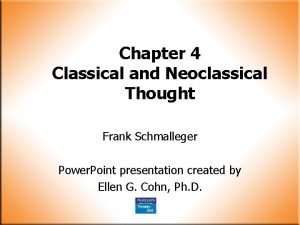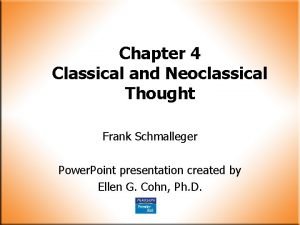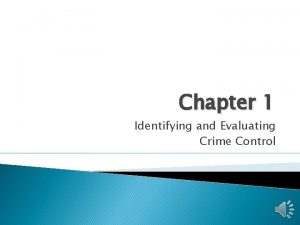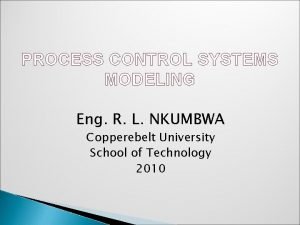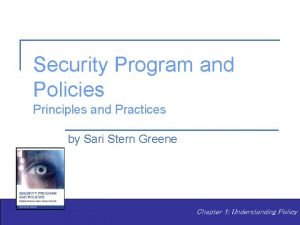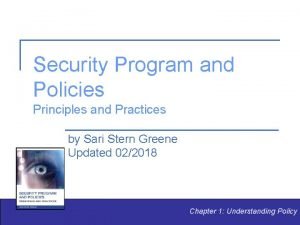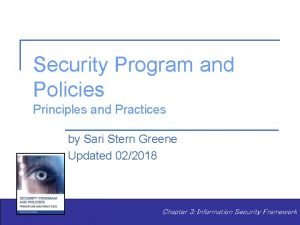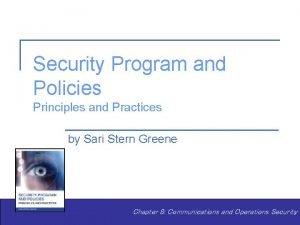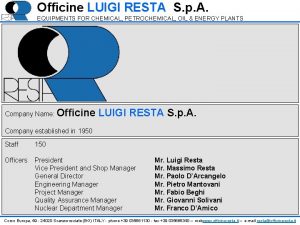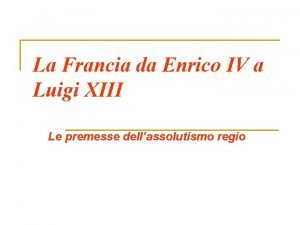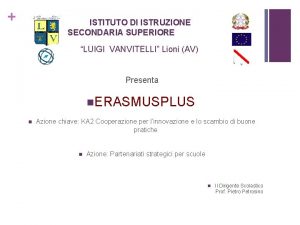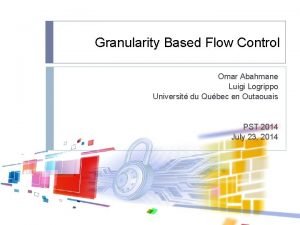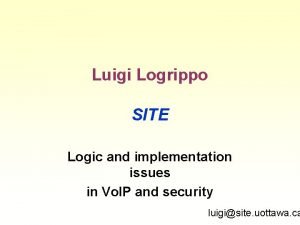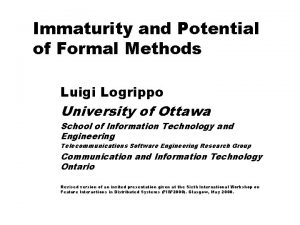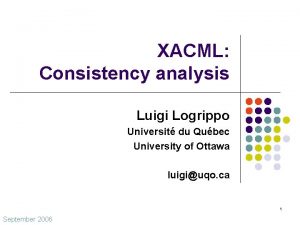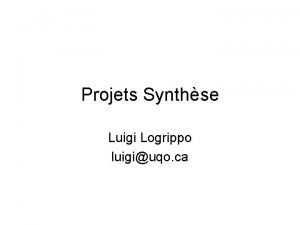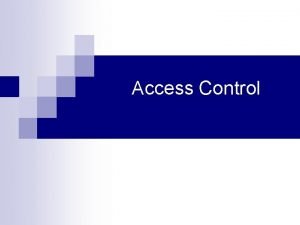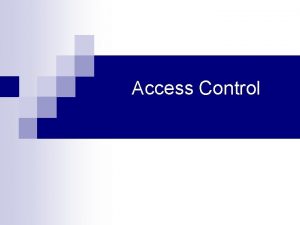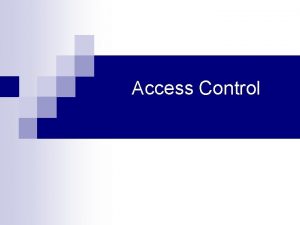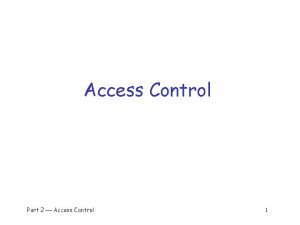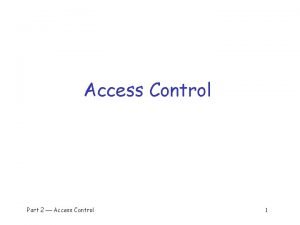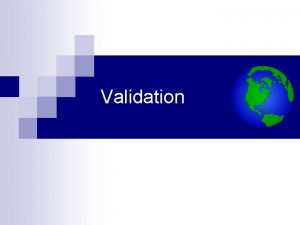Access Control Policies Modeling and Validation Luigi Logrippo































- Slides: 31

Access Control Policies: Modeling and Validation Luigi Logrippo & Mahdi Mankai Université du Québec en Outaouais 1

Overview • • Introduction XACML overview A Logical Model of XACML Modeling with Alloy Access Control Verification and Validation Related Work Conclusion 2

Introduction • Access control policies languages – – XACML EPAL PONDER … • Possible inconsistencies within policies • How to solve inconsistencies at execution time – Precedence rules – Priorities • How to detect inconsistencies at design time – First-order logic – Model-checking tools 3

An example Subject • A policy 1. A professor can read or modify the file of course marks 2. A student can read the file of course marks 3. A student cannot modify the file of course marks • Question: – A subject that is both student and professor wants to modify the file of course marks – Will his request be accepted of refused? • Users and administrators should know about these potential inconsistencies avoid security leaks, denial of service and unauthorized access 4

XACML overview • e. Xtensible Access Control Markup language : an OASIS standard • Architecture, policies and messages Policy Enforcement Point Policy Decision Point 5

XACML Request 6

XACML Structures • A syntax based on XML to define Access Control – Rules – Policies – Policy sets Rule 11 Rule 12 Rule 21 Rule 13 Rule 22 Rule 23 Policy 2 Policy 1 Policy. Set 7

Targets and Conditions Policy 1 Rule N Request Policy 2 Rule 1 Rule N • Not all policies are applied to a request • Targets define the applicability of policy sets, policies and rules • Conditions are additional and more complex filters 8

Rules • Rule – Rule Target – Effect – Condition (optional) (Luigi): Je ne suis pas certain de la signification de ceci. . . 9

Targets • A policy 1. A professor can read or modify the file of course marks 2. A student can read the file of course marks 3. A student cannot modify the file of course marks • Rule 2 is applied when (target) – Subject’s role is “student” – Resource’s name is “course marks” – Action’s name is “read” • Request : a student Bob wants to read the file of course marks – Rule 2 is applied but not Rule 1 nor Rule 3 10

Target subject resource action 11

Combining Algorithms • Mechanisms to resolve conflicts online • Example: – Bob is Ph. D student and an assistant professor, – he wants to modify the file of course marks • Permit-overrides : Permit • Deny-Overrides : Deny • First-Applicable : Permit (Rule 1 appears before Rule 3 in an xml file) • Only-one-applicable : Indeterminate (Error) 12

A Logical Model of XACML • • Use of sets, relations and functions Structures and constraints use of Alloy syntax Alloy – Modeling language – Analyzer tool – Relational first-order logic 13

Alloy • Structural – Signature – Relation • Declarative – first-order logic – facts, predicates, functions, and assertions • Analyzable – Simulation and automatic verification – run predicate – check assertion 14

Examples: Request Relations Sets 15

Basic structures Inheritance as subsetting 16

Structures Expliquer couleurs 17

Constraints • Use of functions and predicates • First order logic 18

Constraints • a predicate that evaluates a request against a target to check whether the target matches the request 19

Constraints • A function that returns the response of a given rule regarding a given request 20

Combining Algorithms 21

Verification and Validation • • • Check properties Use of predicates and assertions Examples 1. An example of a rule returning a permit response regarding a specific request an example? 2. Inconsistency: different rules within the same policy return different decisions (permit and deny) an example? 3. Access should always be granted to a professor requesting modification a counterexample? 22

Access Control Policy – Rule 1 : • A professor can read or modify the file of course marks – Rule 2 : • A student can read the file of course marks – Rule 3 : • A student cannot modify the file of course marks 23

Example 1 • An example of a rule returning a permit response regarding a specific request 24

Example 1 • Rule 2 is applied and returns a permit when a students requests a read access on course marks file 25

Example 2 • Inconsistency: different rules within the same policy return different decision (permit and deny) 26

Example 2 • Both rule 1 and rule 3 are applied when – a subject with both professor and student role tries to modify the file of course marks – rule 3's response is permit – rule 3's response is deny 27

Example 3 • Access should always be granted to a professor (and not student requesting modification • Alloy doesn't find any solution 28

Related work • • MTBDDs to verify XACML policies Conflicts detection tools for PONDER RW verification XACML Other logical approaches 29

Conclusion • XACML validation and verification using model-checking and first-order logic • Only a subset of XACML was covered • A translation tool for transforming XACML policies to Alloy specifications 30

Future work • GUI to permit clear visualization of XACML rules – More intuitive syntax than XACML • GUI to permit editing XACML – Without touching XACML code directly • GUI to display the results of the analysis in user-friendly format – Immediately after editing 31
 Helen erickson biography
Helen erickson biography Terminal access controller access control system plus
Terminal access controller access control system plus Terminal access controller access-control system
Terminal access controller access-control system Dimensional modeling vs relational modeling
Dimensional modeling vs relational modeling Crime control policies
Crime control policies Crime control policies
Crime control policies Crime control policies
Crime control policies Classical and neoclassical theory criminology
Classical and neoclassical theory criminology Crime control policies
Crime control policies Crime control policies
Crime control policies Crime control policies
Crime control policies Control systems modeling
Control systems modeling Sdlc principles and practices
Sdlc principles and practices Recruitment selection and induction
Recruitment selection and induction Security program and policies principles and practices
Security program and policies principles and practices Security program and policies principles and practices
Security program and policies principles and practices Security program and policies principles and practices
Security program and policies principles and practices Security program and policies principles and practices
Security program and policies principles and practices Luigi sabino
Luigi sabino Luigi resta
Luigi resta Luigi, il gran delfino
Luigi, il gran delfino Luigi russolo art of noises
Luigi russolo art of noises Luigi argenziano
Luigi argenziano Madre luigi xiv
Madre luigi xiv Officiers luigi xiv
Officiers luigi xiv Luigi xiv capo della chiesa
Luigi xiv capo della chiesa Istituto luigi vanvitelli lioni
Istituto luigi vanvitelli lioni Luigi gallone
Luigi gallone Luigi gaudio professore
Luigi gaudio professore Luigi russolo dynamika automobilu
Luigi russolo dynamika automobilu Luigi v
Luigi v Väteutdrivande metaller
Väteutdrivande metaller








